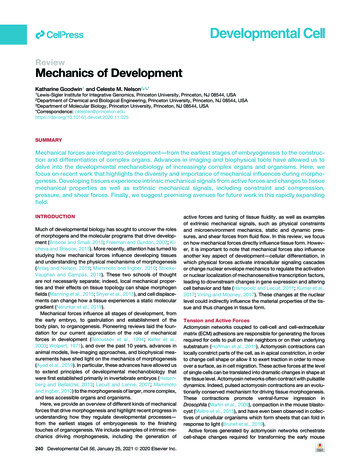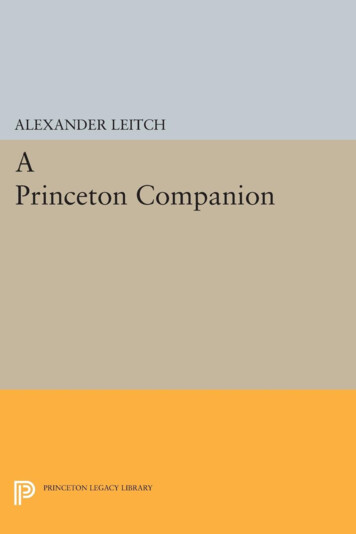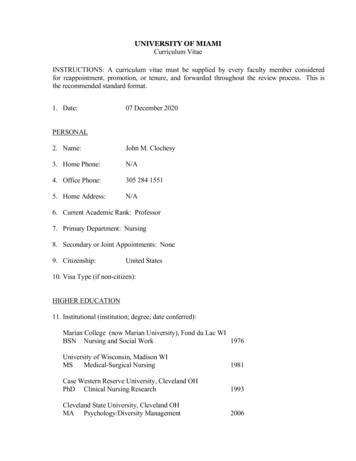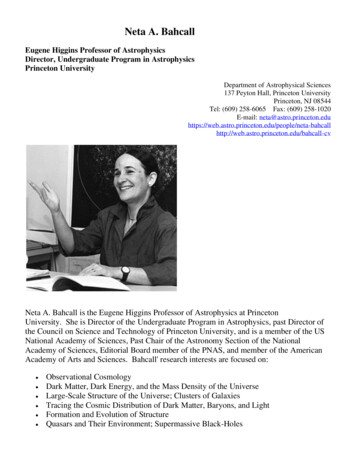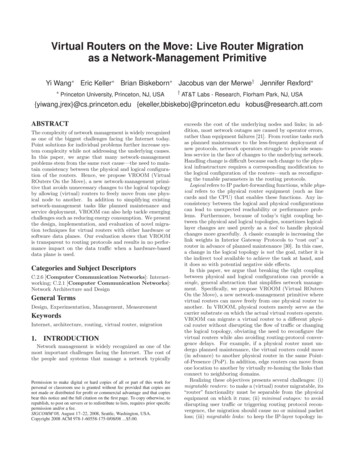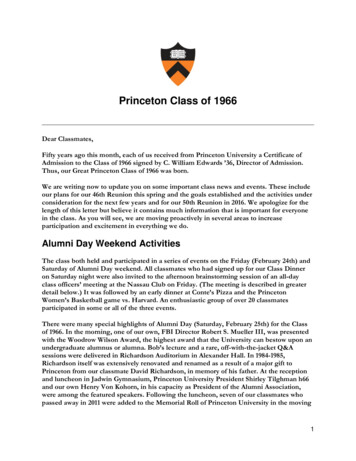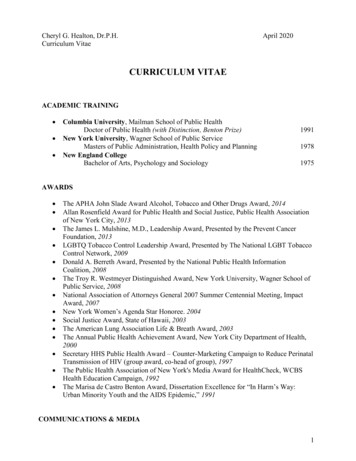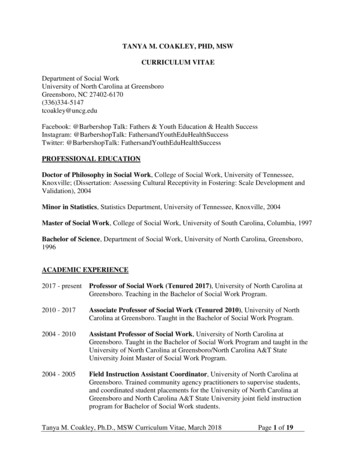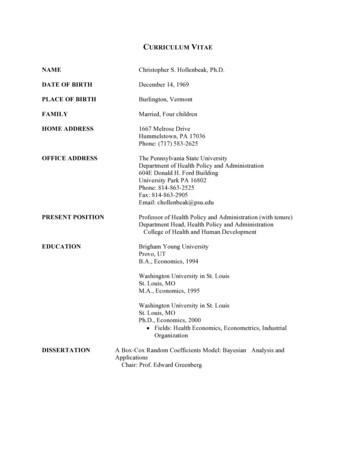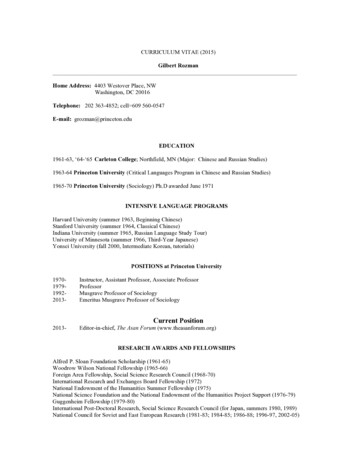
Transcription
CURRICULUM VITAE (2015)Gilbert RozmanHome Address: 4403 Westover Place, NWWashington, DC 20016Telephone: 202 363-4852; cell 609 560-0547E-mail: grozman@princeton.eduEDUCATION1961-63, ‘64-‘65 Carleton College; Northfield, MN (Major: Chinese and Russian Studies)1963-64 Princeton University (Critical Languages Program in Chinese and Russian Studies)1965-70 Princeton University (Sociology) Ph.D awarded June 1971INTENSIVE LANGUAGE PROGRAMSHarvard University (summer 1963, Beginning Chinese)Stanford University (summer 1964, Classical Chinese)Indiana University (summer 1965, Russian Language Study Tour)University of Minnesota (summer 1966, Third-Year Japanese)Yonsei University (fall 2000, Intermediate Korean, tutorials)POSITIONS at Princeton University1970197919922013-Instructor, Assistant Professor, Associate ProfessorProfessorMusgrave Professor of SociologyEmeritus Musgrave Professor of Sociology2013-Editor-in-chief, The Asan Forum (www.theasanforum.org)Current PositionRESEARCH AWARDS AND FELLOWSHIPSAlfred P. Sloan Foundation Scholarship (1961-65)Woodrow Wilson National Fellowship (1965-66)Foreign Area Fellowship, Social Science Research Council (1968-70)International Research and Exchanges Board Fellowship (1972)National Endowment of the Humanities Summer Fellowship (1975)National Science Foundation and the National Endowment of the Humanities Project Support (1976-79)Guggenheim Fellowship (1979-80)International Post-Doctoral Research, Social Science Research Council (for Japan, summers 1980, 1989)National Council for Soviet and East European Research (1981-83; 1984-85; 1986-88; 1996-97, 2002-05)
Committee on Scholarly Communication with the PRC (1984-85, 1992)Chiang Ching-kuo Foundation Fellow, ACLS (1992-93)United States Institute of Peace (1994-96)Woodrow Wilson International Center for Scholars (1996-97, 2010-11)Center for Global Partnership (1997-98)Carnegie Corporation of New York, International Peace and Security Program (2000-2001)Yonsei University (Seoul), visiting professor (2000, fall)Seoul National University, visiting professor (2005, fall)The Korea Foundation (2005-06, 2009-10)East Asia Institute Fellow, Seoul (2006)Northeast Asian History Foundation (2007-08)United States-Japan Foundation (2009-10)Korean Economic Institute, organizer of panels and volumes (2011-15)ADMINISTRATIVE POSITIONS AND PROGRAM COMMITTEES,PRINCETON UNIVERSITYDirector, Council on Regional Studies, 1993-97Director, Title VI International Studies Program, 1993-97Acting Chair, Department of Sociology, 1991-92Director of Graduate Studies, Department of Sociology, 1972-73,1975-79, 1983-87, 1988-92, 2003-04, 2007-08Program Committee in East Asian Studies, 1973-2913Program Committee in Russian Studies, 1977-2013Editorial Board, Princeton University Press, 1981-85Program Committee in Population Studies, 1988-93Senior Fellow, Princeton Society of Fellows, Woodrow Wilson Foundation, 1991-94Chair, Committee on International Experience in Undergraduate Education, 1993-96Fulbright Scholarship interview committee, 1998-2000Director, PIIRS project on Strategic Thought in Asia, 2004-07Director, PIIRS, EAS Program project on East Asian National Identities, 2008-10PROFESSIONAL ACTIVITIES AND MEMBERSHIPSAmerican Council of Learned Societies, Member of the Committee on Studies of Chinese Civilization,1975-80-Chairman, Subcommittee on Social Science Studies of Traditional China, 1975-80International Research and Exchanges Board, Member of the US-USSR Binational Commission on theSocial Sciences and Humanities, 1978-1986-Chairman, Subcommittee on East Asian Studies, 1978-84; Member University Council, 1998-2001Committee to Visit East Asian Studies, Harvard University, 1999-2006Senior Fellow, Foreign Policy Research Institute, Philadelphia, 1998American Sociological Association, 1970-2010Association of Asian Studies, 1970-2015, chair Program Committee, 2009-10American Association for the Advancement of Slavic Studies (AAASS), 1970-2015
Editorial Boards:Asian SurveyJournal of East Asian StudiesIIRPUBLICATIONSBooks:Urban Networks in Ch’ing China and Tokugawa Japan (Princeton University Press, 1973)The Modernization of Japan and Russia (coauthor, The Free Press, 1975)Urban Networks in Russia, 1750-1800, and Premodern Periodization (Princeton University Press,1976)The Modernization of China (ed., The Free Press, 1981)Population and Marketing Settlements in Ch’ing China (Cambridge University Press, 1982)Soviet Studies of China: Assessments of Recent Scholarship (ed., Michigan Publications on China,1984)A Mirror for Socialism: Soviet Criticisms of China (Princeton University Press, 1985)Japan in Transition: From Tokugawa to Meiji (coeditor, Princeton University Press, 1986)The Chinese Debate about Soviet Socialism, 1978-1985 (Princeton University Press, 1987)The East Asian Region: Confucian Heritage and Its Modern Adaptation (ed., Princeton UniversityPress, 1991)Japan’s Response to the Gorbachev Era, 1985-1991: A Rising Superpower Views A DecliningOne (Princeton University Press, 1992)Dismantling Communism: Common Causes and Regional Variations (ed., Johns HopkinsUniversity Press, 1992)Russia and East Asia: The 21st Century Security Environment (co-editor, M.E. Sharpe, 1999)Japan and Russia: The Tortuous Path to Normalization, 1949-1999 (ed., St. Martin’s Press, 2000)Northeast Asia’s Stunted Regionalism: Bilateral Distrust in the Shadow of Globalization(Cambridge University Press, 2004)Korea at the Center: Dynamics of Regionalism in Northeast Asia (coeditor, M.E. Sharpe, 2006)Russian Strategic Thought toward Asia (co-editor, Palgrave, 2006)Japanese Strategic Thought toward Asia (co-editor, Palgrave, 2007)Strategic Thinking about the Korean Nuclear Crisis: Four Parties Caught between North Koreaand the United States (Palgrave, 2007, revised paperback edition in 2011)
South Korean Strategic Thought toward Asia (co-editor), Palgrave, 2008)Chinese Strategic Thought toward Asia (Palgrave, 2010, revised paperback edition in 2012)U.S. Leadership, History, and Bilateral Relations in Northeast Asia (editor), (Cambridge, 2011)East Asian National Identities: Common Roots and Chinese Exceptionalism (editor), (WoodrowWilson Center Press and Stanford University Press, 2012)China’s Foreign Policy: Who Makes It, and How Is It Made? (editor), (Asan Institute, 2012).Joint U.S.-Korea Academic Studies--Asia at a Tipping Point: Korea, the Rise of China, and theImpact of Leadership Transitions (editor), (Korea Economic Institute, 2012).National Identities and Bilateral Relations: Widening Gaps in East Asia and ChineseDemonization of the United States (editor), (Woodrow Wilson Center Press and StanfordUniversity Press, 2013).Joint U.S.-Korea Academic Studies--Asia’s Uncertain Future: Korea, China’s Aggressiveness,and New Leadership (editor), (Korea Economic Institute, 2013).The Sino-Russian Challenge to the World Order: National Identities, Bilateral Relations, and Eastvs. West in the 2010s (Woodrow Wilson Center Press and Stanford University Press, 2014).Joint U.S.-Korea Academic Studies--Asia’s Slippery Slope: Triangular Tensions, Identity Gaps,Conflicting Regionalism, and Diplomatic Impasse toward North Korea (editor), (Korea EconomicInstitute, 2014).Misunderstanding Asia: International Relations Theory and Asian Studies over Half a Century(editor) (Palgrave Macmillan, 2015).Asia’s Alliance Triangle: U.S.-Japan-South Korea Relations at a Tumultuous Time (editor throughThe Asan Forum) (editor) (Palgrave Macmillan, 2015).Joint U.S.-Korea Academic Studies—Facing Reality in East Asia: Tough Decisions onCompetition and Cooperation (editor) (Korea Economic Institute, 2015).International Relations and Asia’s Southern Tier: ASEAN, Australia, and India (coeditor withJoseph Liow) (SpringerNature, 2016).Articles:Encyclopedia Articles and Overviews“The Sociology of East Asia: A Growing Force in Regional Studies,” in Asia in the Twenty-FirstCentury: Toward a New Framework of Asian Studies (Tokyo: Institute of Oriental Culture,University of Tokyo, 1996), pp. 1-9.“Hanjungil samguk oe yugyo wa segyehwa” (Korea, China, Japan: Three countries’ Confucianismand Globalization), Chontong gwa hyondae, No. 3, 2000, pp. 207-30.“East Asian Studies: Society,” in Neil J. Smelser and Paul B. Battes, eds., InternationalEncyclopedia of the Social Sciences (Oxford: Elsevier Science Ltd, 2001), pp. 3975-79.“Japan-Russia Relations,” in David Levinson and Karen Christensen, et al., eds.,
Encyclopedia of Modern Asia (New York: Scribner’s, 2002), Vol. 3, pp. 244-48.“Integrating Russian Studies into Northeast Asian Studies,” AAASS Newsletter, March 2002, pp.1-4.“Japan’s Relations with the U.S. and Its North Korean Option,” Foreign Policy Research InstituteE-notes, Dec. 3, 2002.“The Far East Region,” James R. Millar, ed., Encyclopedia of Russian History, Vol. 2 (NewYork: Macmillan Reference, 2004), pp. 481-82.“Modernization Theory,” in New Dictionary of the History of Ideas (New York: Scribner’s, 2004).1974-79Soviet Reinterpretations of Chinese Social History," Journal of Asian Studies (November 1974),49-72. Republished without permission as "Criticisms of Soviet Revisionists' Distortions ofChina's Social History," Waiguo Yanjiu Zhongguo 3 (1979), 75-117."Edo's Importance in the Changing Tokugawa Society," Journal of Japanese Studies (Fall 1974),91-112."Comparative Approaches to Urbanization: Russia, 1750-1800," in Michael Hamm, ed., The Cityin Russian History (University of Kentucky Press, 1975), 69-85."The Skinner Bibliography of Modern Chinese Society: Ch'ing Research, 1644-1895," Journal ofAsian Studies (February 1976), 283-87."Two Sources of Population Data for Nineteenth-Century China," Ch’ing-Shih Wen-T’i (Fall1977), 72-78."China's Traditional Cities," Pacific Affairs (Winter 1977), 668-72."Introduction," to reprint of Posadskaia Obshchina v Rossi XVIII Stoletiia, by A.A. Kizevetter(Oriental Research Partners, 1978), 1-7."Urban Networks and Historical Stages," Journal of Interdisciplinary History 9:1 (Summer 1978),65-91. Republished in Theodore Rabb and Robert I. Rotberg, eds., Industrialization andUrbanization (Princeton University Press, 1981).“Social Interdependence in the Premodern Era,” “Social Interdependence in the Transition toModernization,” “Social Interdependence and Advanced Modernization,” in The Modernization ofJapan and Russia, pp. 74-100, 198-216, 308-22."Comparisons Between China and the Soviet Union: The Sociology of Socialism," ContemporaryChina 2:2 (Summer 1978), 18-23.“Social Integration in the Eighteenth and Nineteenth Centuries,” “Social Integration in theTwentieth Century,” “Summary: Eighteenth and Nineteenth Centuries,” Summary: TwentiethCentury,” “The PRC as a Modernizing Society,” “China’s Modernization in HistoricalPerspective,” in The Modernization of China, pp. 141-82, 352-400, 203-16, 443-54, 455-81, 482516.1980-89
"The Social Order," in The Cambridge Encyclopedia of China (Cambridge: CambridgeUniversity Press, 1982), 112-21."Moscow's China-Watchers in the Post-Mao Era: The Response to a Changing China," The ChinaQuarterly 94 (June 1983), 215-41."Demographic Variables in Chinese History: A Perceived Challenge to the Theory of ClassStruggle," in Albert Feuerwerker, ed., Chinese Social and Economic History from the Song to1900: Report of the American Delegation to a Sino-American Symposium (Ann Arbor: MichiganMonographs in Chinese Studies 45, 1982), 37-42.“Castle Towns in Transition,” in Marius B. Jansen and Gilbert Rozman, eds., Japan in Transition:From Tokugawa to Meiji (Princeton: Princeton University Press, 1986), pp. 318-46."China's Soviet-Watchers in the 1980s: A New Era in Scholarship," World Politics 37:4 (July1985), 435-74.“Restricted Circulation," Friends of the Gest Library, (1987) 19-25."Chinese Comparisons of Socialism: A New Agenda for Research and New Perceptions ofConvergence in Socialist Reforms," in Tsuyoshi Hasegawa, ed., The Soviet Union Faces Asia:Perceptions and Policies (Sapporo: The Slavic Research Center, Hokkaido University, 1987), 2136."The Comparative Study of Socialism in China: The Social Sciences at a Crossroads," SocialResearch, 54:4 (Winter 1987), 631-61."Moscow's Japan-Watchers in the First Years of the Gorbachev Era: The Struggle for Realismand Respect in Foreign Affairs," Pacific Review (1988), Vol. 1, No. 3, pp. 257-75."Japan's Soviet-Watchers in the First Years of the Gorbachev Era: The Search for a Worldviewfor the Japanese Superpower," Pacific Review, (1988) Vol. 1, No. 4, pp. 412-28."Social Change," in Marius B. Jansen, ed., The Cambridge History of Japan; Vol. 5, TheNineteenth Century, (Cambridge: Cambridge University Press, 1989), pp. 499-568.1990-94"'Roshia Soren o shiru jiten' no Roshiia Soren zo" (The Image of Russia and the Soviet Unionfrom the "Dictionary to Know about Russia and the Soviet Union"), Gekkan Hakka, No. 336,October 1990, pp. 21-25."East Asian Urbanization in the Nineteenth Century: Comparisons with Europe," in A. Van derWoude, et. al., eds., Urbanization in History, Oxford: Clarendon Press (1990), pp. 61-73."Shades of Excellence: The Communist Party and Elites in China and the Soviet Union," in MelGurtov, ed., The Transformation of Socialism: Perestroika and Reform in the Soviet Union andChina (Boulder: Westview Press, 1990), pp. 155-77."The Rise of the State in China and Japan," in Michael Mann, ed., Rise and Decline of the NationState (Oxford: Basil Blackwell, 1990), pp. 172-187.
"Rising Soviet Expectations for the Asian-Pacific Region" (Ajia-taiheiyo chiiki e muketetakamaru Soren no kitai), Soren no kiki to Nisso kankei (Tokyo, 1991), pp. 86-96 and 243-69.“Introduction: The East Asian Region in Comparative Perspective,” “Comparisons of ModernConfucian Values in China and Japan,” in The East Asian Region, 1991, pp. 3-42, 157-203."Theories of Modernization and Theories of Revolution: China and Russia," in Zhongyangyanjiuyuan jindaishi yanjiusuo, ed., Zhongguo Xiandaihua Luanwenji (Taipei, 1991), pp. 633-46.“Stages in the Reform and Dismantling of Communism in China and the Soviet Union,” inDismantling Communism: Common Causes and Regional Variations, 1992, pp. 15-58."The Confucian Faces of Capitalism," in Mark Borthwick, ed., The Emergence of Modern PacificAsia (Boulder, Colorado: Westview Press, 1992), pp. 310-22."Value Change, Marketization, and Enterprise Paternalism in China and Russia," in Power Shiftsand Value Changes in the Post Cold War World (Takahashi, Okayama: The Joint Symposium ofthe International Sociological Association's Research Committees in Comparative Sociology andSociology of Organizations, Kibi International University, 1992), pp. 127-43."Japanese Images of the Soviet and Russian Role in the Asia-Pacific Region," in Hasegawa,Haslam, and Kuchins, eds., Russia and Japan (Berkeley: Institute of East Asia, University ofCalifornia, 1993), pp. 101-123."Japanese Views of the Great Powers in the New World Order," in David Jacobsen, ed., OldNations, New World: Conceptions of World Order (Boulder, CO: Westview Press, 1994), pp. 1535."Chinese Studies in Russia and their Impact, 1985-1992," Asian Research Trends, No. 4 (1994),pp. 143-60.1995"East Asian Modernization and the Japanese Experience," in Eric Wu and Yun-han Chu, eds., ThePredicament of Modernization in East Asian (Taipei: National Cultural Association, 1995), pp.111-26."A Regional Approach to Northeast Asia," Orbis, Vol. 39, No. 1 (Winter 1995), pp. 65-80."Spontaneity and Direction Along the Russo-Chinese Border," in Stephen Kotkin and DavidWolff, eds., Rediscovering Russia in Asia: Siberia and the Russian Far East (Armonk, NY: M.E.Sharpe, 1995), pp. 275-89."Gendai tohoku Ajia no seiji keizai" (The Political Economy of Contemporary Northeast Asia), inHokuto Ajia Chiiki No Shomondai (Niigata, Japan: Kenritsu Niigata joshi tanki daigaku, 1995),pp. 131-44.“Current Cooperation in the Region of the Sea of Japan: Building Networks of MultinationalCooperation,” United Nations Symposium on Northeast Asia: Multi-Faceted Cooperation inNortheast Asia (United Nations, 1995).1996
“Nihon to Chugoku no kindaika ni kansuru hikaku” (Comparisons of the Modernization of Japanand China), in Yamada Tatsuo and Nakai Yoshihiko, eds., Nitchu Hikaku Kindaika Ron(Modernization Theory Comparing Japan and China) (Kyoto, 1996), pp. 31-56.“Chugoku toshi eriito no jukyoteki dento to shakaishugiteki kaikaku no tempo” (The ConfucianTraditions of China’s Urban Elite and Prospects for Socialist Reforms) in Yamada Tatsuo, ed.,Rekishi No Naka No Gendai Chugoku (Contemporary China in the Light of History) (Tokyo,1996), pp. 53-81.1997“China, Japan, and the Post-Soviet Upheaval: Global Opportunities and Regional Risks,” in KarenDawisha, ed., The International Dimension of Post-Communist Transitions in Russia and the NewStates of Eurasia (Armonk, NY: M.E. Sharpe, 1997), pp. 147-76.“The Crisis of the Russian Far East: Who Is to Blame?” Problems of Post-Communism, Vol. 44,No. 5, September/October 1997, pp. 3-12.“Troubled Choices for the Russian Far East: Decentralization, Open Regionalism, andInternationalism,” The Journal of East Asian Affairs, Vol. 11, No. 2, Summer/Fall 1997, pp. 53769.“Cross-National Integration in Northeast Asia: Geopolitical and Economic Goals in Conflict,”East Asia: An Interdisciplinary Journal, Vol. 16, No. 2, Spring/Summer, 1997, pp. 6-43.“Confucian Ethics and Legitimacy of Authority in China and Japan,” in Michele Schmiegelow,ed., Democracy in Asia (Frankfurt and New York: Campus Verlag and St. Martin’s Press, 1997),pp. 93-112.1998“The Great Power Balance in Northeast Asia,” review article, Orbis, Vol. 42, No. 1, Winter 1998,pp. 130-42.“The Sino-Russian Strategic Partnership: Will It Endure?” Demokratizatsiya, Vol. 6, No. 2, Spring1998, pp. 396-415.“Sino-Russian Relations in the 1990s: A Balance Sheet,” Post-Soviet Affairs, Vol. 14, No. 2,Spring 1998, pp. 93-113.“Flawed Regionalism: Reconceptualizing Northeast Asia in the 1990s,” Pacific Review, Vol. 11,No. 1, 1998, pp. 1-27.“Northeast Asia: Regionalism, Clash of Civilizations or Strategic Quadrangle?” Asia-PacificReview, Vol. 5, No. 1, Spring/Summer 1998, Tokyo, pp. 105-26.“Northeast China: Waiting for Regionalism,” Problems of Post-Communism, Vol. 45, No. 4, JulyAugust 1998, pp. 3-13.“Decentralization in Northeast China and the Russian Far East,” The Soviet and Post-Soviet
Review, Vol. 25, No. 2, 1998, pp. 181-97.1999“China’s Quest for Great Power Identity,” Orbis, Vol. 43, No. 3, Summer 1999, pp. 383-402;reprinted in Guoli Liu, ed., Chinese Foreign Policy in Transition (New York: Aldine DE Gruyter,2004).“The Strategic Quadrangle and the Northeast Asian Region,” in Rouben Azizian, ed., Strategicand Economic Dynamics of Northeast Asia (Auckland: Center for Strategic Studies, University ofAuckland, 1999), pp. 8-21.“Mutual Perceptions among the Great Powers in Northeast Asia,” in Tsuneo Akaha, ed., Politicsand Economics in Northeast Asia: Nationalism and Regionalism in Contention (New York: St.Martin’s Press, 1999), pp. 31-59.“Backdoor Japan: The Search for a Way Out via Regionalism and Decentralization,” Journal ofJapanese Studies, Vol. 25, No. 1, Winter 1999, pp. 3-31.“The Role of Northeast Asian Cities in a Global Urban Network,” The Korean Journal ofRegional Science, Vol. 15, No. 2, October 1999, pp. 5-19.2000“Sino-Russian Mutual Assessments,” in Sherman Garnett, ed., Rapprochement or Rivalry?Russia-China Relations in a Changing Asia (Armonk, NY: M.E. Sharpe, 2000), pp. 147-74.“A New Sino-Russian-American Triangle?” Orbis, Vol. 44, No. 4, Fall 2000, pp. 541-55.“Russia and the United States in the Great Power Context,” in Zhang Yunling and Guo Weihong,eds., China, US, Japan and Russia in a Changing World (Beijing: Social Sciences DocumentationPublishing House, 2000), pp. 163-75.“Russia and Japan: Mutual Misperceptions, 1992-1999,” in Semyon Verbitsky, TsuyoshiHasegawa,and Gilbert Rozman, eds., Misperceptions between Japan and Russia (Pittsburgh:University of Pittsburgh, The Carl Beck Papers in Russian & East European Studies, 2000), pp.70-86.“Restarting Regionalism in Northeast Asia,” North Pacific Policy Papers 1 (Vancouver: Programon Canada-Asia Policy Studies, Institute of Asian Research, 2000), pp. 2-21.“Kita Taiheiyo no chiiki kyoryoku—21 seiki ni mukete kawaru senryaku” (Regional Cooperationin the North Pacific: Changing Strategy at the Turn of the Century), NIRA Policy Research, Vol.13, No. 3 (March 2000), pp. 9-13.“Turning Fortresses into Free Trade Zones,” in Sherman Garnett, ed., Rapprochement or Rivalry?Russia-China Relations in a Changing Asia (Armonk, NY: M.E. Sharpe, 2000), pp. 177-202.“Japan and Russia: Great Power Ambitions and Domestic Capacities,” in Japan and Russia, 2000,pp. 365-84.
“Cross-Border Relations and Russo-Japanese Bilateral Ties in the 1990s,” in Japan and Russia,2000, pp. 199-214.2001“Japan’s Images of China in the 1990s: Are They Ready for China’s ‘Smile Diplomacy’ or Bush’s‘Strong Diplomacy?’” Japanese Journal of Political Science, Vol. 2, Part 1, May 2001, pp. 97125.”The Northeast Asian Regional Context for Environmentalism: Assessing Environmental Goalsagainst Other Priorities in the 1990s,” Journal of East Asian Studies, Vol. 1, No. 2, August 2001,pp. 13-30.2002“Japan’s Quest for Great Power Identity,” Orbis, Vol. 46, No. 1, Winter 2002, pp. 73-91.“Russia’s Calculus and Japan’s Foreign Policy in Pacific Asia,” in Takashi Inoguchi, ed., Japan’sAsian Policy: Revival and Response (New York: Palgrave, 2002), pp. 167-91.“Challenges for United States Foreign Policy in the 21st Century: Engagement and Globalizationacross the Pacific,” in Robert Rabel, ed., The American Century? In Retrospect and Prospect(Boulder, CO: Praeger, 2002), pp. 69-84.“Japan and South Korea: Should the U.S. Be Worried about Their New Spat in 2001?” PacificReview, Vol. 15, No. 1, 2002, pp. 1-28.“The Intensified Search for a Solution to the Territorial Dispute: September 11 Fosters Progress inRusso-Japanese Relations,” Russian Regional Report, Jan. 16, 2002, pp. 6-10.“Perekinut’ most ot Evropy k Azii cherez Rossiiu” (To lay a bridge from Europe to Asia acrossRussia) YuRussia/Yevropeets, Jan. 22, 2002, pp.“A Chance for a Breakthrough in Russo-Japanese Relations: Will the Logic of Great PowerRelations Prevail?” Pacific Review, Vol. 15, No. 3, 2002, pp. 325-57.“China’s Changing Images of Japan 1989-2001: The Struggle to Balance Partnership andRivalry,” International Relations of the Asia-Pacific, Vol. 2, No. 1 (Winter 2002), pp. 95-129.“Can Confucianism Survive in an Age of Universalism and Globalization?” Pacific Affairs, Spring2002, Vol. 75, No. 1, pp. 11-37; reprinted in Xinzhong Yao and Wei-ming Tu, eds., ConfucianStudies: Critical Concepts (London: Routledge, 2010).“Decentralization in East Asia: A Reassessment of Its Background and Potential,” Developmentand Society, Vol. 31, No. 1, June 2002, pp. 1-22.“Decentralized Regionalism in Northeast Asia: How Have Things Changed in 2001?” FinalReport on International Conference on Regional Cooperation in Northeast Asia: Appraisals andProspects (Pusan: Busan Development Institute, 2002), pp.“International Relations of Northeast Asia in the US: Area Studies, Disciplines, and Regional
Coverage,” Journal of East Asian Studies, Vol. 2, No. 1 (2002), pp. 139-63.2003“Japan’s North Korean Initiative and U.S.-Japanese Relations,” Orbis, Vol. 47, No. 3, Summer2003, pp. 527-39.“The Geopolitics of the North Korean Nuclear Crisis,” in Richard J. Ellings and Aaron L.Friedberg, eds., Strategic Asia 2003-04: Fragility and Crisis (Seattle: The National Bureau ofAsian Research, 2003), pp. 245-61.“Obzor rossiiskikh predstavlenii o Vostochnoi Azii, 1972-2003,” (Reinterpreting Russian Imagesof East Asia, 1972-2003), NZ, No. 3, Summer 2003, pp. 42-47.“Sino-Japanese Relations: Mutual Images and the Balance between Globalization andRegionalism,” Woodrow Wilson International Center, Asia Program Special Report 113, July2003, pp. 8-13.“Networks that Must Change: Regional Exchange in Northeast Asia Seen from the U.S.”(Kawariyuku ikinai nettowakku: Amerika goshukoku kara mita hokuto Ajia chiikikan koryu),Kokusai koryu, No. 98, January 2003, pp. 12-17.“When Will Russia Really Enter Northeast Asia?” in Wolfgang Danspeckgruber and StephenKotkin, eds., The Future of the Russian State: A Sourcebook (New York: Columbia InternationalAffairs Online, 2003), pp.“Searching for National Identity in Japan and China,” Journal of East Asian Studies, Vol. 3, No. 3,Sept.-Dec. 2003, pp. 523-28.“Center-Local Relations: Can Confucianism Boost Decentralization and Regionalism?” in DanielA. Bell and Hahm Chaibong, eds., Confucianism for the Modern World (Cambridge: CambridgeUniversity Press, 2003), pp. 181-200.“The US and Asia,” Asian Survey, No. 1, 2003, co-author, pp. 1-14.2004“China’s Perspective on the World,” in International Workshop, External Strategy of the NewChinese Leadership (Tokyo: The Japan Institute of International Affairs, 2004), pp. 1-7“Vlianie national’nogo samoopredeleniia na Kitaisko-Rossiiskie otnosheniia,” (Influence ofNational Identity on Sino-Russian Relations), in A. D. Dikarev, A. V. Lukin, and E. A. Sinetskaia,eds., Obshchestvo i gosudarstvo v Kitae (Moscow: Vostochnaia literature RAN, 2004), pp. 96108.“Russian Foreign Policy in Northeast Asia,” in Sam Kim, ed., The International Relations ofNortheast Asia (Lanham, MD: Rowman & Littlefield, 2004), pp. 201-24.“Hokuto Ajia ni okeru regionalism no shitten ni mukete: Beikoku no ambivalence o kofuku suru,”(Toward a Breakthrough in Northeast Asian Regionalism: Overcoming US Ambivalence), NIRAseisaku kenkyu, Vol. 17, No. 1, 2004, pp. 24-28.
“Democratization in Greater China: The Northeast Asian Regional Context,” Orbis, Vol. 48, No.2, Spring 2004, pp. 217-31.2005“Maneuvering over the Russian Far East’s Place in Northeast Asia,” in F. Joseph Dresen, ed.,Russia in Asia—Asia in Russia: Energy, Economics, and Regional Relations (Washington, DC:Kennan Institute Occasional Paper #292, 2005), pp. 77-81.“Sino-Japanese Competition over the Russian Far East: Is the Oil Pipeline Only a Starting Point,”in Akihiro Iwashita, ed., Siberia and the Russian Far East in the 21st Century: Partners in the“Community of Asia,” Vol. 1, Crossroads in Northeast Asia (Sapporo: 2005), pp. 1-20.2006“Cultural Prerequisites of East Asian Regionalism in an Age of Globalization,” Korean Observer,Vol. 37, No. 1 (Winter 2006), pp. 149-79.“Chiikishugi e no tosen: Chugoku to Nihon no akarasamana chokusetsuteki taiko kankei,” (AChallenge for Regionalism: Open, Direct Rivalry of China and Japan) in Aichi daigaku kokusaimondai kenkyujo ed., 21 seiki niokeru Hokutoajia no kokusai mondai (International Relations ofNortheast Asia in the 21st Century) (Tokyo: Toho shoten, 2006), pp. 19-46.“South Korean-Japanese Relations as a Factor in Stunted Regionalism,” IRI Review, Vol. 11, No.1, Spring 2006, pp. 99-124.“New Challenges in the Regional Integration of China and Japan in 2005,” in Satow Toyoshi andLi Enmin,eds., The Possibility of an East Asian Community: Rethinking the Sino-JapaneseRelationship (Tokyo: Ochanomizu shobo, 2006), pp. 389-410.“Introduction,” in Charles K. Armstrong, Gilbert Rozman, Samuel S. Kim, and Stephen Kotkin,eds., Korea at the Center, pp. ix-xiii.“Regionalism in Northeast Asia: Korea’s Return to Center Stage,” in Charles K. Armstrong,Gilbert Rozman, Samuel S. Kim, and Stephen Kotkin, eds., Korea at the Center, pp. 151-66.(coauthor), “Overview,” in Russian Strategic Thought toward Asia, pp. 1-33.“Russian Strategic Thought toward Regionalism,” in Russian Strategic Thought toward Asia, pp.229-53.“Sino-Japanese Competition over the Korean Peninsula: The Nuclear Crisis as a Turning Point,”in Jonathan D. Pollack, ed., Korea: The East Asian Pivot (Newport, RI: Naval War College Press,2006), pp. 287-306.“Sino-Japanese Relations in the Russian Shadow,” in Lam Peng Er, ed., Japan’s Relations withChina: Facing a Rising Power (London: Routledge, 2006), pp. 213-33.“Unravelling the Japan-South Korea ‘Virtual Alliance’: Populism and Historical Revisionism inthe Face of Conflicting Regional Strategies,” (with Shin-wha Lee), Asian Survey, Vol. 46, No. 5,September/October 2006, pp. 661-84.
“What Chinese Characteristics? Looking to the Past for Clues about the Future,” in Jae Ho Chung,ed., Determinants of China’s Future: Political, Social, and International Dimensions (Boulder,CO: Rowman & Littlefield, 2006), pp. 191-206.2007(coauthor), “Overview,” in Japanese Strategic Thought toward Asia, pp. 1-32.“Japanese Strategic Thinking on Regionalism,” in Japanese Strategic Thought toward Asia, pp.243-68.“Russia in Northeast Asia: In Search of a Strategy,” in Robert Legvold, ed., Twenty-first CenturyRussian Foreign Policy and the Shadow of the Past (New York: Columbia University Press,2007), pp. 343-92.“Reshuffling Priorities for Northeast Asian Security: Revisionism, Regionalism, Reunification,and Realism,” Korea Observer, Vol. 38, No.2 (Summer 2007), pp. 259-83; reprinted in HyungKook Kim, Myongsob Kim, and Amitav Acharya, eds., Northeast Asia and the Two KoreasMetastability, Security, and Community (Seoul: Yonsei University Press, 2008), pp. 73-105.“National Identities in East Asia in the Shadow of Globalization,” in A New East Asia: Toward aRegional Community (Singapore: National University of Singapore Press, 2007), pp. 221-27.“Visions of Northeast Asian Regionalism: The United States and Republic of Korea,”Mansfield Foundation E-Newsletter, June 2007“Russia’s Resurgence in Northeast Asia: Views from the Region,” in Robert Orttung, et. al. eds.,Russia’s Foreign Policy: Key Regions and Issues Forschungsstelle Osteuropa BremenArbeitspapiere und Materialien , No.87 (Nov. 2007), pp. 45-48.“South Korea and the Sino-Japanese Rivalry: A Middle Power’s Options within the East AsianCore Triangle,” Pacific Review, Vol. 20, No. 2, June 2007, pp. 197-220.“The United States and the North Korean Nuclear Crisis: Views from China, Japan, Russia, andS
1963-64 Princeton University (Critical Languages Program in Chinese and Russian Studies) 1965-70 Princeton University (Sociology) Ph.D awarded June 1971 INTENSIVE LANGUAGE PROGRAMS Harvard University (summer 1963, Beginning Chinese) Stanford University (summer 1964, Classical Chinese) . From Tokugawa to Meiji (coeditor, Princeton University .
